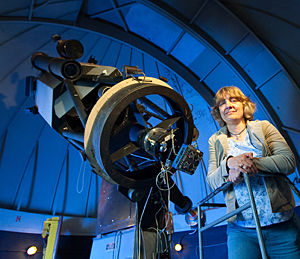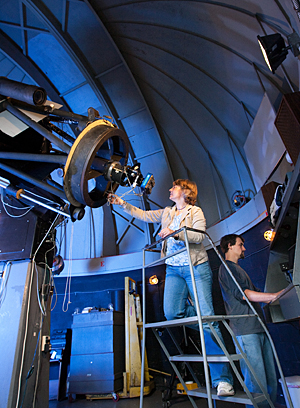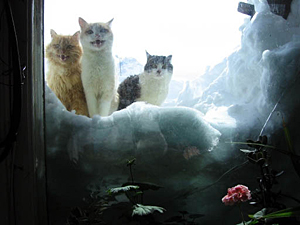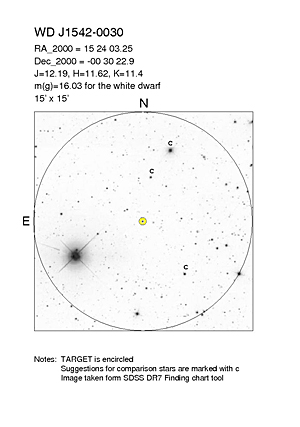





- Rozovsky wins prestigious NSF Early Career Award
- UD students meet alumni, experience 'closing bell' at NYSE
- Newark Police seek assistance in identifying suspects in robbery
- Rivlin says bipartisan budget action, stronger budget rules key to reversing debt
- Stink bugs shouldn't pose problem until late summer
- Gao to honor Placido Domingo in Washington performance
- Adopt-A-Highway project keeps Lewes road clean
- WVUD's Radiothon fundraiser runs April 1-10
- W.D. Snodgrass Symposium to honor Pulitzer winner
- New guide helps cancer patients manage symptoms
- UD in the News, March 25, 2011
- For the Record, March 25, 2011
- Public opinion expert discusses world views of U.S. in Global Agenda series
- Congressional delegation, dean laud Center for Community Research and Service program
- Center for Political Communication sets symposium on politics, entertainment
- Students work to raise funds, awareness of domestic violence
- Equestrian team wins regional championship in Western riding
- Markell, Harker stress importance of agriculture to Delaware's economy
- Carol A. Ammon MBA Case Competition winners announced
- Prof presents blood-clotting studies at Gordon Research Conference
- Sexual Assault Awareness Month events, programs announced
- Stay connected with Sea Grant, CEOE e-newsletter
- A message to UD regarding the tragedy in Japan
- More News >>
- March 31-May 14: REP stages Neil Simon's 'The Good Doctor'
- April 2: Newark plans annual 'wine and dine'
- April 5: Expert perspective on U.S. health care
- April 5: Comedian Ace Guillen to visit Scrounge
- April 6, May 4: School of Nursing sponsors research lecture series
- April 6-May 4: Confucius Institute presents Chinese Film Series on Wednesdays
- April 6: IPCC's Pachauri to discuss sustainable development in DENIN Dialogue Series
- April 7: 'WVUDstock' radiothon concert announced
- April 8: English Language Institute presents 'Arts in Translation'
- April 9: Green and Healthy Living Expo planned at The Bob
- April 9: Center for Political Communication to host Onion editor
- April 10: Alumni Easter Egg-stravaganza planned
- April 11: CDS session to focus on visual assistive technologies
- April 12: T.J. Stiles to speak at UDLA annual dinner
- April 15, 16: Annual UD push lawnmower tune-up scheduled
- April 15, 16: Master Players series presents iMusic 4, China Magpie
- April 15, 16: Delaware Symphony, UD chorus to perform Mahler work
- April 18: Former NFL Coach Bill Cowher featured in UD Speaks
- April 21-24: Sesame Street Live brings Elmo and friends to The Bob
- April 30: Save the date for Ag Day 2011 at UD
- April 30: Symposium to consider 'Frontiers at the Chemistry-Biology Interface'
- April 30-May 1: Relay for Life set at Delaware Field House
- May 4: Delaware Membrane Protein Symposium announced
- May 5: Northwestern University's Leon Keer to deliver Kerr lecture
- May 7: Women's volleyball team to host second annual Spring Fling
- Through May 3: SPPA announces speakers for 10th annual lecture series
- Through May 4: Global Agenda sees U.S. through others' eyes; World Bank president to speak
- Through May 4: 'Research on Race, Ethnicity, Culture' topic of series
- Through May 9: Black American Studies announces lecture series
- Through May 11: 'Challenges in Jewish Culture' lecture series announced
- Through May 11: Area Studies research featured in speaker series
- Through June 5: 'Andy Warhol: Behind the Camera' on view in Old College Gallery
- Through July 15: 'Bodyscapes' on view at Mechanical Hall Gallery
- More What's Happening >>
- UD calendar >>
- Middle States evaluation team on campus April 5
- Phipps named HR Liaison of the Quarter
- Senior wins iPad for participating in assessment study
- April 19: Procurement Services schedules information sessions
- UD Bookstore announces spring break hours
- HealthyU Wellness Program encourages employees to 'Step into Spring'
- April 8-29: Faculty roundtable series considers student engagement
- GRE is changing; learn more at April 15 info session
- April 30: UD Evening with Blue Rocks set for employees
- Morris Library to be open 24/7 during final exams
- More Campus FYI >>
Editor's note: Prof. Provencal says you can view the target white dwarf WDJ1524-0030 if you have a telescope with a lens that is at least 6 inches in diameter and know where to look. Use the finder's chart on this Web page or on the DARC Web site.
3:24 p.m., May 15, 2009----The Whole Earth Telescope (WET), a worldwide network of observatories coordinated by the University of Delaware, is synchronizing its lenses to provide round-the-clock coverage of a cooling star. As the star dims in the twilight of its life, scientists hope it will shed light on the workings of our own planet and other mysteries of the galaxy.
The dying star, a white dwarf identified as WDJ1524-0030, located in the constellation Ophiuchus in the southern sky, is losing its brightness as it cools, its nuclear fuel spent. It will be monitored continuously from May 15 to June 11 by WET, a global partnership of telescopes which was formed in 1986.
Like an international relay team, observers at Mt. Cuba Observatory in Greenville, Del., will focus on and photograph the white dwarf until sunrise, and then observers at McDonald Observatory in Fort Davis, Texas, and at Kitt Peak National Observatory in Tucson, Ariz., will stand watch while the star is in their sky, followed by observers in New Zealand, Australia, China, and so on, around the globe.
The thousands of photographs of the white dwarf taken by WET will be e-mailed to the command center at Mt. Cuba Observatory staffed by University of Delaware researchers, for archiving and eventual analysis using the fledgling science of “star quakes” known as asteroseismology.
“A white dwarf is the size of the Earth and as dense as the sun. This star pulsates or quakes as waves of energy travel through it -- its outer surface sloshes from side to side, like waves on the ocean,” says Judi Provencial, assistant professor of physics and astronomy at UD and director of the Delaware Asteroseismic Research Center (DARC).
“What is of interest to scientists is the shape of the pulses,” Provencal notes. “From them, we can measure how the atmosphere is moving around in these pulsating stars and figure out what's going on inside them. This one is really sloshing around.”
There are thousands of white dwarfs in our galaxy; however, only about 30 percent are bright enough for scientists to study using asteroseismics, which can determine the age, temperature and composition of a star from its oscillations and brightness.
Provencal says that WDJ1524-0030 is one of only about 20 percent of the stars in the universe whose atmosphere is composed of helium versus hydrogen. The WET team hopes to find out the composition of the star's core, whether hydrogen or oxygen.
The process of discovery will take on the order of two years to stitch together all of the images, analyze the data, interpret the data with the input of the WET community and report the results. Eventually, the findings will be applied to other stars, including the sun, and to our own planet, Provencal says.
“We don't understand the weather on Earth, the transport of energy,” she says. “We don't understand convection at all. Hopefully, this field of research, which is still very new, will help every aspect of astronomy.”
Putting the Observing Run into Focus
Organizing all of the telescopes for an observing run may seem akin to aligning the planets. More than 20 telescopes are participating in the current run. Provencal and Susan Thompson, co-director of DARC, needed to submit applications for some of the major telescopes several years in advance.
Only one in five proposals typically gets selected by such competitive research facilities as the William Herschel Telescope in the Canary Islands. With a lens that is 4.2 meters in diameter, the telescope is the largest that has signed on to participate, Provencal says.
Before the advent of the Internet, Provencal says she and her colleagues at the command center used to have to call each observatory on the telephone to participate.
“In South Africa, we had to call the international operator, who could only get out to the telescope by a hand-cranked phone and you could hear that in the background. The Internet has taken some of the fun out of that, but France still likes to be called every day of the observing run,” Provencal says. “And at Peak-Turskol in Russia, the astronomers say they have several cats that like to participate.”
Provencal says that she and her colleagues in the WET community like to study cooling stars “because it's cool.”
While the administration of the Whole Earth Telescope is supported by the Crystal Trust Foundation, the observers are not paid to observe.
“Without them, it wouldn't happen,” she says. “It's a community effort.”
Participating telescopes
These observatories are participating in the Whole Earth Telescope’s international observing run, which UD is coordinating, to monitor the white dwarf WDJ1524-0030. Telescope lens diameter is in parentheses:
- Beijing Astronomical Observatory (BAO), China (2.1 m/6.9 ft)
- Bohyunsan Optical Astronomy Observatory (BOAO), South Korea (1.8 m/5.9 ft)
- Cerro Tololo Inter-American Observatory (CTIO), Chile (0.9 m/3 ft)
- Institut für Astronomie und Astrophysik Tübingen, Germany (0.8 m/2.6 ft)
- Kitt Peak National Observatory, Arizona, USA (2.1 m/6.9 ft)
- Las Cumbres Observatory, California, USA
- Lulin Observatory, Taiwan (1 m/3.2 ft)
- McDonald Observatory, Texas, USA (2.1 m/6.9 ft)
- Moletai Astronomical Observatory, Lithuania (1.5 m/4.9 ft)
- Mt. Abu Observatory, India (1.2 m/3.9 ft)
- Mt. Cuba Astronomical Observatory, Delaware, USA (0.6 m/2 ft)
- Mt. John Observatory of the University of Canterbury, New Zealand (1 m/3.2 ft)
- Mt. Suhora Astronomical Observatory, Cracow Pedagogical University, Poland (0.6 m/2 ft)
- Observatoire de Haute-Provence (OHP), France (1.93 m/6.3 ft)
- Observatrio del Teide, Tenerife, Canary Islands, Spain (0.6 m/2 ft)
- Osservatorio Astronomico di Bologna, Italy (1.5 m/4.9 ft)
- Peak Terskol Observatory, Russian Federation (2 m/6.6 ft)
- South African Astronomical Observatory (SAAO), South Africa (1 m/3.2 ft)
- Southern Astrophysical Research Telescope (SOAR), Chile (4.2 m/13.8 ft)
- Paul and Jane Meyer Observatory, Texas, USA (0.6 m/2 ft)
- Southeastern Association for Research in Astronomy Observatory (SARA), Florida, USA (1 m/3.2 ft)
- Vienna Observatory, Austria (0.68m/2.2 ft)
Article by Tracey Bryant


